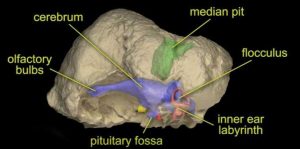
Credit: Stocker et al.
A newly described species of extinct reptile that roamed in Texas more than 200 million years ago had a strikingly dome-shaped head, much like that of dinosaurs that lived 100 million years or so later. Like the wings of pterosaurs and birds and the limblessness of snakes and some amphibians, the study reported in the Cell Press journal Current Biology on September 22 offers an example of convergent evolution between distantly related species of vertebrates.
“We were surprised to find something like Triopticus primus at all!” says Michelle Stocker of Virginia Polytechnic Institute and State University. “There was nothing else like that known from the Triassic period, and we wouldn’t have guessed that we would find something that looked like that outside of the Cretaceous period. Our team was also surprised that the internal structure of the skull of Triopticus was similar to pachycephalosaur dinosaurs–it wasn’t just an external similarity.”
Inside Triopticus’ domed head composed of thickened bone, CT scans revealed internal partitions or zones. Stocker says that it’s hard to say what advantage the reptile’s head structure would have offered, but it’s clear that none of its close relatives had a similar appearance.
The dinosaurs that would have lived alongside Triopticus in the Triassic period were small, lightweight, and carnivorous, she adds. They also walked on two legs.
Interestingly, the long-lost reptile is just one of many other taxa found in the well-preserved Otis Chalk assemblage in Texas that show a resemblance to post-Triassic dinosaurs.
“The Triassic period may have been a time of experimentation with respect to body plans,” Stocker says. “Reptiles were diversifying after the end-Permian mass extinction, and this may have been an opportunity for evolution to operate quickly and with few constraints.”
At the same time, however, such adaptive radiations of new species might reach an “early saturation of possible shapes, which then delimit what may be possible and are later repeated,” she says.
Reference:
Current Biology, Stocker et al.: “A Dome-Headed Stem Archosaur Exemplifies Convergence among Dinosaurs and Their Distant Relatives” DOI: 10.1016/j.cub.2016.07.066
Note: The above post is reprinted from materials provided by Cell Press.










